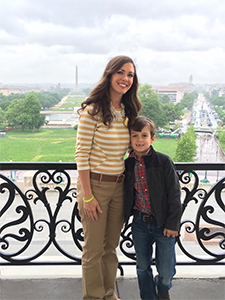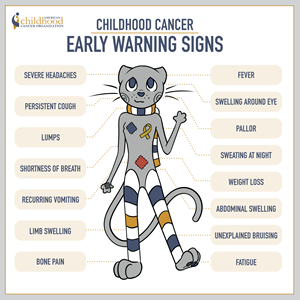Easing the Burden of Children and Families Dealing with Cancer
Posted on by
By Jamie Ennis Bloyd, MPA
Director of Government Relations and External Affairs
American Childhood Cancer Organization
You may be surprised to learn that every 3 minutes a family hears the devastating words that their child has been diagnosed with cancer. As a part of the American Childhood Cancer Organization (ACCO), I work to make the lives of children and families suffering from cancer easier. At ACCO, we provide free information and resources that benefit not just the child who has been diagnosed but also the entire family, including siblings.
My involvement with ACCO is very personal. In 2014, my son was diagnosed with cancer at the age of five. He had a very aggressive, stage four cancer that required eight rounds of chemotherapy. Getting to the diagnosis was a journey in of itself. I took him to the doctor nine times after weeks of fever of unknown origin and a rapidly growing lymph node on the left side of this throat. We were repeatedly told that it was likely just a virus and a reactive lymph node and that he would get better. Finally, I found a doctor that I trusted and knew would listen to do surgery and a biopsy and this is where our cancer journey began. Unfortunately, I know my family’s experience isn’t unusual.
Childhood Cancer
Like me before my own son was diagnosed, many people don’t know that childhood cancer is the number one cause of death by disease for children in the United States, and around the world. This year, more than 11,000 new cases of cancer will be diagnosed among children from birth to 14 years, and, sadly, more than 1,000 will die. When a child is diagnosed with cancer, the impact is far spreading. Besides the emotional toll that cancer takes on a family, there are many logistical things to be considered. Often a parent has to quit their job to provide care to the child. There’s the transportation to and from treatments, the many missed school days, caring for siblings, and of course dealing with insurance and the financial cost.
Although we’ve seen progress in recent years related to childhood cancer, there continue to be gaps in areas where more effort could be beneficial. Some of these areas may include better training for pediatricians and other health care providers, more state-level engagement with state cancer action plans, and more consideration for the long-term effects for children treated for cancer. We want to help people recognize that childhood cancer is an important public health problem.
Survivors of Childhood Cancer
In 2015, there were an estimated 429,000 survivors of childhood cancer in the United States. Sometimes we see people reach the magical “five-year mark” where they have been free of cancer for five years and we think they are in the safe zone. Although this is an important milestone, the reality is that for childhood cancer survivors it’s really something they, and their entire family, will deal with for a lifetime.
Many cancer survivors deal with late effects. Late effects are health problems that occur months or years after treatment has ended. The cancer or the cancer treatment may cause some of these effects. Survivors can deal with major consequences like infertility, cardiovascular issues, and even a secondary cancer. These are only the physical effects. Many survivors suffer from anxiety and depression. There’s also the resource consideration of time and money required for regular follow-up appointments and ongoing financial toxicity for families.

Looking Ahead
I am encouraged by recent progress in the field of childhood cancer. There continues to be more of an organized effort to gather accurate and timely data related to children diagnosed and treated for cancer so that every child’s diagnosis counts. We can learn from these experiences. The Childhood Cancer Survivorship, Treatment, Access, and Research (STAR) Act of 2018 supports increased research related to childhood cancer. It also supports CDC’s National Program of Cancer Registries to collect childhood cancer data more quickly so data can be available to researchers much sooner. The goal of the legislation is to help advance efforts to find new treatments and improve quality of life for childhood cancer survivors.
Above all, I want to empower all parents and caregivers to be advocates for their children. It’s definitely a daunting feeling knowing there isn’t a lot you can do to prevent childhood cancer. We can, however, learn and spread the word about early warning signs and symptoms. Some of these include unusual bruising, lumps, fever, fatigue, vision changes, and headaches. If you’re not sure you’re getting the correct advice or diagnosis, don’t be afraid to get a second opinion. I can tell you from experience that no parent will ever regret being persistent. Early diagnosis and intervention is so important.
On September 7th, 2019, my son reached his magical five-year mark of treatment, and for that I am so grateful. I know though that his journey ahead is long and will still be full of challenges. I hope that we’ll continue to make strides in supporting childhood cancer fighters and survivors and that eventually fewer families will receive that forever life-altering and heartbreaking news that their child has cancer.
One comment on “Easing the Burden of Children and Families Dealing with Cancer”
Comments listed below are posted by individuals not associated with CDC, unless otherwise stated. These comments do not represent the official views of CDC, and CDC does not guarantee that any information posted by individuals on this site is correct, and disclaims any liability for any loss or damage resulting from reliance on any such information. Read more about our comment policy ».


50 years ago, we didn’t have Wi-Fi routers in schools bathing (irradiating) continuously all students and teachers with invisible, silent, odorless and tasteless pulsed, NON-thermal electric-magnetic field (EMF) radiation – that honest scientists globally know CAUSES cancers and most if not all of today’d disease epidemics (although not exclusively).
50 years ago, we didn’t have cell phones, cordless phones, cell phone towers, GPS (global positioning system), Bluetooth devices, desktop-laptop and table computers, wireless security systems, etc. that also bathe us constantly with hazardous pulsed NON-thermal EMFs!
100 years ago, we didn’t have AM or FM radio stations that continuously bathed the public (as they still do) with hazardous modulated NON-thermal RF EMFs.
120 years ago, we didn’t have 50 Hz/60 Hz electricity lighting/heating/cooling our homes/buildings and on which all of our electrical appliances, tools, machinery, etc. depend – each and every one of which emits hazardous NON-thermal EMFs.
Yet ignorant and/or corrupt governments together with greedy, callous, profit-focused telecom industry is determined to FORCE upon every man, woman and child – without their knowledge or permission – yet more pulsed NON-thermal EMFs – from more than 20,000 satellites and – simultaneously – from literally millions of microcell towers in front of every 2nd to 10th home in every community on earth! And we wonder why children are getting cancer? This is what is being called “5G” (fifth generation) technology.